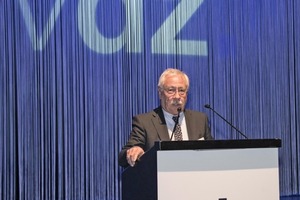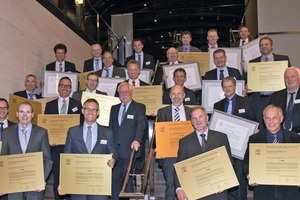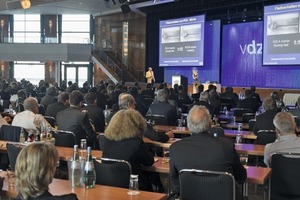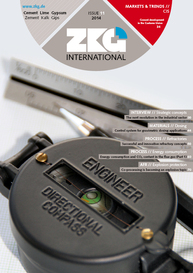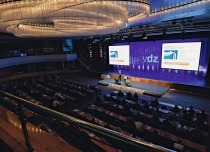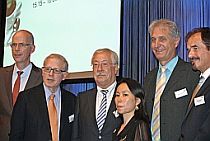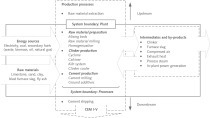Security of energy supply and quality becoming key topics
Following a speech of welcome by VDZ president Gerhard Hirth (Fig. 1) to the more than 350 representatives of the German cement industry, science, practice and mechanical and plant engineering, Dr. Martin Schneider, general manager of the VDZ, led the audience at the annual conference in Düsseldorf into the many-facetted agenda.
The tone was set from the start with a contrast of viewpoints between political fundamentalism and everyday practice. The original Club of Rome concepts, interestingly enough, were again the starting point for the address by Ralf Fücks (Heinrich Böll Foundation), who cited climatic and socio-political grounds for his roadmap for a successful Energy Turnaround, Version 2.0. He noted, in particular, the departure from a “linear” resources industry from the source to the landfill, vigorously advocated the separation of resources and the value chain, and focussed on the abandonment of atomic energy and coal-based power generation. It is apparent that the large utilities now supply only 12 % of total German energy needs, whereas no less than 47 % comes from citizens organised into co-operatives and 41 % from strategic investors, who feed electricity into the grid from their wind, hydroelectric, solar and biomass power plants. He mentioned Asia and America where, he claimed, much larger alternative energy-generation capacities have already been installed than in Europe, as a prime example. The Foundation does not, in this context, perceive any acute cost increases and even expects “zero energy costs” in the long term, but it was nonetheless not possible to provide an answer to the very practical question of affordable and assured energy supplies for the cement industry during this transitional period.
The real everyday life of the operator of an ultra-modern range of power-generating plants looks totally different, however: Sven Becker, management spokesman for Trianel GmbH, illustrated most impressively exactly what it means to have to guarantee assured energy supplies while, on the other hand, not being able to utilise one’s efficient capacities cost-effectively as a result of the politically desirable energy turnaround and the priority assigned to renewable energy sources. Trianel is not a classical energy supply corporation, having originated, instead, as an alliance of municipal utilities, the initial purpose of which was the bulk purchase of electricity at advantageous rates. This subsequently evolved into a consortium for the construction and, later, also the operation, of power-generating plants. Its current “fleet” of plants includes not only wind and biomass facilities, but also gas- and modern coal-fuelled plants with efficiencies ranging up to 50 %. In the context of the energy turnaround currently under discussion, the political world has, regrettably, neglected the difference between “output” and “capacity”, for which reason the state opportunistically regulates capacity and thus fatally interferes in a market which has, up to now, been financed only via output (i.e., actual power consumption). This means that the installed, modernised, and also highly efficient back-up capacities must be prematurely written off and decommissioned, a step which, for its part, would result in full utilisation of the capacities of long-amortised fossil-fired power plants and in increasing CO2 emissions. In short, the current electricity-market model is not suitable for the long-term, efficient and macroeconomically rational achievement of assuredness of supply. Market-economy principles must be guaranteed, whereby decentralised generation, virtually centralised and equipped with storage facilities, could indeed be the key to the energy turnaround.
Following the coffee break, Klaus Pöllath, of the German Concrete and Construction Engineering Association, examined the boundary conditions for construction using concrete. The volume of German investment in construction is currently around € 3000 per head of the population; measured against GDP, which rose by 30 % between 1991 and 2013, the volume of construction has thus neither declined nor risen. The range of cements has increased significantly, nonetheless, and lower-cost but higher-quality standard products can be supplied, with a high level of specialisation. In the long term, however, Pöllath anticipates change in the construction industry: there will be fewer general contractors available for major projects, but more specialists, with a need for greater co-ordination as a result. More building for protection against extreme weather occurrences (floods, heatwaves, storms) will take place, as a consequence of climate change, with concomitant architectural implications.
These perceptions were also emphasised by Prof. Dr. Jürgen Schnell, of the University of Kaiserslautern’s Institute of Concrete Structures and Structural Engineering, who noted that two thirds of building activity in Germany is now on existing sites. The question then arises, of course, of the compatibility of the applicable standards, since modern standards apply to new building projects, whereas old materials used in accordance with old requirements are to be found in the existing stock of buildings. Thanks to the existing standards and their surveillance, 74 % of possible building collapses have occurred with the first five years; i.e., one building collapses every 1 000 000 years. It is thus assured - from a statistical viewpoint - that old buildings also meet present-day needs completely, and that there is no “exigent circumstance” (danger in delay), which does not mean, however, that building activities can be pursued on existing sites without further consideration and, above all, without an appropriate safety concept.
Following an academic pause for breath, during which Michael Miersch, of the FOCUS Media Verlag publishing house, explained why, despite economic crises, wars, epidemics, environmental disasters, etc., he remains a notorious optimist (he has the knack of ignoring the news which, in any case, is only good news if it’s bad news!), the first day of the conference concluded with the presentation (Fig. 2) of the VDZ Health and Safety Award (good news!) and dinner in an informal atmosphere (even better news!).
The spotlight on the following day was on process engineering and concrete technology. Prof. Dr. Johann Plank, of the Chair of Building Chemistry at the TU Munich, reminded the audience of the story of SKW, the company which took up and systematically researched a discovery made in highway engineering, and rose in this way to be a pioneer in admixtures. He explained the enormous development potential, citing examples from history, which has resulted, inter alia, in it being possible to construct ever higher buildings. It is even conceivable, in the more distant future, that concrete could be translucent, phototropic or even piezoelectric, thanks to admixtures, or that cracks will be “healed” by lime-secreting bacteria.
Georg Don-Preisendanz, of ThyssenKrupp Steel Europa AG, explained how a modern blast furnace must be lined and operate energy-efficiently in order to remain competitive. The lining itself, the burden, the ore, the additives and the scrap charged all play an enormously important role, as does the method used for granulation of the slag to make ground granulated blast furnace slag (GGBFS), in order to prepare the composition of the slag optimally for further use. Production of GGBFS is currently at a stable level, making it possible to guarantee and maintain the parameters necessary for the production of cement. GGBFS makes an important contribution to the sustainability strategy and enhancement of efficiency in cement production. A long-enduring discussion has obviously now come to a fruitful end (good news!).
The use of power-plant fly ash as a building material is now well established, but the political discussion surrounding the energy turnaround does nonetheless raise a number of questions. According to Burkhard Jakobuß, of BauMineral GmbH, the quantities involved, and quality trends, result in significant downstream complexity in Quality Assurance and in the management of silo capacities and logistics. Optimised power-plant operation, in interaction with civil-engineering standards and codes, still holds great potential, however, as he noted.
Dr. Jörg-Peter Wagner (Bilfinger Construction GmbH) examined the site-relevant properties which concrete is ultimately required to meet in the structure. Project execution and the detailed project specification are becoming ever more demanding, circumstances which naturally have a direct influence on the properties of both the green and the curing concrete. Ever larger and heavier concrete components, underwater concretes, higher strength categories for industrial flooring systems, and continuously-formed concrete structures are, for example, increasingly in demand.
Problems arise, however, due to the fact that the site-relevant properties cannot, in many cases, be entirely quantified, cannot be agreed, and cannot, therefore, be monitored. Updating to take account of rapidly advancing concrete technology has not yet occurred. Wagner therefore proposes the introduction of so-called “implementation classes”, in which the concretes, the building methods, the components and the purpose are defined, and are causally linked via Quality Assurance provisions.
Eckhard Bohlmann (HeidelbergCement) examined the question of what comes after cement and concrete, since cements with multiple principal constituents are the core element in sustainable cement and concrete production in Germany. The vital factors are high availability and access to suitable feed materials and resources. The environment-policy boundary conditions and wishes currently prove more of a hindrance than an aid in harmonising climate-protection and energy-efficiency, since people want durable high-quality concrete structures at affordable cost. Bohlmann also advocates additional QA provisions, i.e., precise definition of concrete engineering methods, for the production and use of concrete, in order that project clients and planners can better define their expectations of the result and implement them in practice.
In the afternoon, the auditorium was split into two parallel sessions, with Peter Lyhs (CEMEX), in the field of concrete technology, examining the alkali/silica reaction from a practical viewpoint, while Bernd Gerhke (Pagel Spezialbeton GmbH & Co. KG) focussed in more detail on textile-reinforced concrete for structural reinforcement and for repair purposes. Dr. Sebastian Palm, of VDZ, took the example of new cements to present durability-related indicator data. After the coffee break, Eugen Kleen (MC-Bauchemie) continued, speaking on the global challenges in admixtures and concretes. Dr. Olaf Aßbrock (German Ready-Mixed Concrete Association [BTB]) closed this session with a presentation of the results of cooperation between the VDZ and the BTB on further training in the ready-mixed concrete industry.
Stephan Schenk (Lafarge Zement Wössingen), kicking off the afternoon plenary process session, discussed the provisions which have assisted in achieving optimised use of secondary fuels at the Wössingen plant. The fundamental precondition, he noted, is a modern rotary kiln possessing maximum flexibility and permitting the use of various alternative fuels and raw materials (AFR).
Optimised use of alternative fuels is based, he stated, not only on optimum technical preconditions, but also on good PR work, in order to assure public and official acceptance. Close cooperation between the operator and the supplier, maintenance, production, quality management and staff training have resulted in a Thermal Substitution Rate of >80 %. These provisions have, in fact, also achieved improved emissions and product quality, and reduced “classical” cyclone blockages.
Dr. Detlef Edelkott (Schwenk Zement KG) was able, after four years of operation and optimisation of a high-dust SCR system, to note that the emissions limits of 200 mg NO2/m³ and 30 mg/m³ NH3 can be met with certainty and with high availability (>95 %). Interestingly enough, it proved possible, via the use of the catalyst, to fix more than 90 % of elemental mercury ionically, and remove it together with the dust. A reduction in organic emissions (of up to 90 % in the case of polycyclic aromatic hydrocarbons; dioxins, furans and benzene: up to 60 %) was also observed.
Limitation of operating temperature to 300° C made it possible to cut losses caused by reductant burn-off, and to anticipate catalyst-element campaigns of not less than four years.
Similarly positive experience was also reported by Dr. Helmut Leibinger (Südbayrische Portland-Zementwerke Gebr. Wiesböck), who spoke on the SCR system at his company’s Rohrdorf plant after three years of operating experience. Activity losses are 12 %, for an availability of 97 %. NOx emissions have been cut by 76 %, NH3 by 93 % and volatile organic carbon (VOC) by 50 %. Specific energy consumption, at 5.6 kWh/t clinker, is somewhat higher than for the high-dust SCR variant, with its 5 kWh/t clinker.
Dr. Peter Kalkert, of KIMA Echzeitssysteme, unveiled a new kiln-shell cooling strategy, in which hot spots are detected automatically by means of infrared temperature sensors and water then fed, precision metered, with low noise and energy-economically, with pin-point accuracy to the kiln shell, thus cooling it under careful control.
Dr. Martin Oerter (VDZ) concluded the session with his paper on the quantitation of biogenic CO2 in industrial waste-gases, in which he illustrated the importance of precise quantification of the CO2 mass flow in order to permit measurement of greenhouse-gas emissions. The combination of modern in-situ measuring technologies for the determination of CO2 concentration and volumetric flow of gas are highly promising, although the high rate of measuring error undermines the achievement of the current ambitious targets. Determination of the biogenic CO2 content in the waste-gas does, it is true, achieve accordance with the input provisions, but requires validation by means of further measurements. The influence of non-steady-state conditions (e.g. start-up and shut-down, compound and direct operation, etc.) has also not yet been totally clarified.
//www.vdz-online.de" target="_blank" >www.vdz-online.de:www.vdz-online.de

